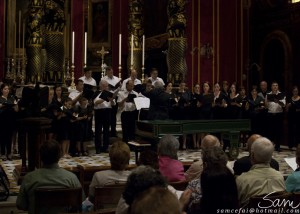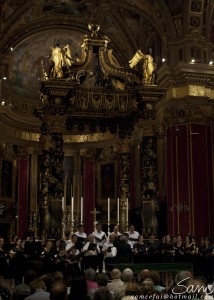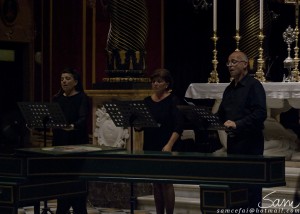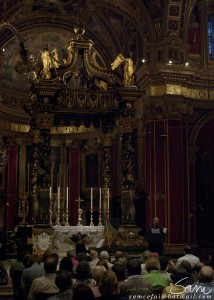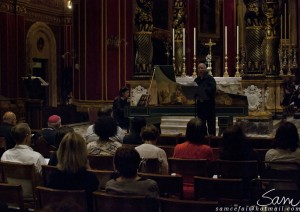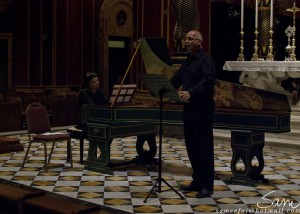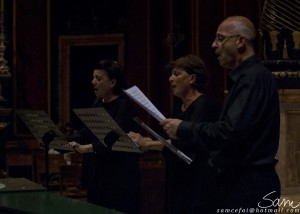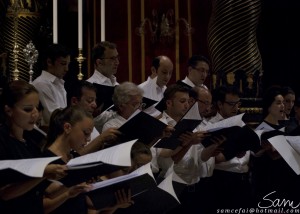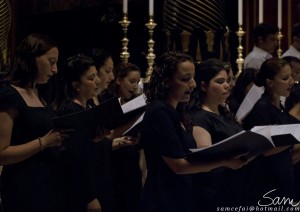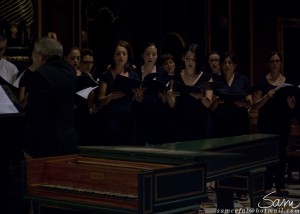Superb Roberto Colavalle and Laudate Pueri Choir
Roberto Colavalle gets better with every hearing. A leading member of the legendary Cappella Sistina Choir he proved his formidable mettle when he performed 6 wonderful Baroque arias, ranging from Scarlatti to Cesti to Caldara and others, in that gorgeous voice of his.
Blessed with a very beautiful voice, consummate technique and, even better, a musicality that gives that edge to his performances, he regaled the audiences with the sheer musical power of his interpretations. Accompanied on the harpsichord by Maria Frendo gave that authentic touch to the performance. The recital started with O cessate di piagarmi by Alessandro Scarlatti. This short aria, as interpreted by Roberto, reached the apotheosis of the singing voice which eventually led to the sublime bel canto of Donizetti, Bellini and others. Here, the audience was faced with the work of a romanticist with a penchant for melancholy in the softly elegiac melodies which captivate and enthrall. These melodies and arias are not patterns; on the composer’s mental stage there are no puppets but real dramatic figures, living men and women whose language is melody. There is the Baroque penchant for extravagance, even in feeling and the speaker here wishes to die for he cannot suffer his torment of unrequited love any longer. With such words for inspiration Scarlatti weaves arguably one of the most beautiful arias ever written. Characteristic of the evening’s interpretation were Roberto’s ease with high pitch (going to a high F), and his long phrases which give the impression that the singer is actually even singing over the rests, prompting the comparison with Milton’s words “notes of many a winding bout of linked sweetness long drawn out”.
Next came Caldara’s Come raggio di sol. Again another plaintive work, the text describes hidden depths of troubled emotions, and the music portrays this vividly. The instrumental chords that opened the piece are highly repetitive, and the voice even stays on the same note when it enters for several notes. The phrasing remained highly subdued, in keeping with the concept of largely hidden emotions, and so the singer and harpsichordist had only the inflections with which to communicate. There are no stunning leaps or vocal acrobatics, or even attention-grabbing discords; only the restrained, subdued lines. Throughout, this aria was full of sweetness and the rapport between singer and accompanist was sound and intelligent. On the other hand, Scarlatti’s All’aquisto di gloria is a robust work, fast and acrobatic in places. Roberto passed from one style to the next in a natural and seamless manner. Fanfare-like, the comparatively lengthy introduction on the harpsichord announced the melismatic flourishes that characterized this piece. Written in the typical ternary form, the second section is in the characteristic minor mode before a recapitulation of the main part is tackled with verve and panache.
Cesti’s Intorno all’idol mio and Fasolo’s Cangia, cangia tue voglie are similar in that they share a cantabile tone and a haunting, ethereal quality to the texture of the works. Roberto’s voice has that very special and unique quality in that while it belongs to the most upper ranges of a male voice, it retains wonderful shades of colour that more ‘normal’ counter tenor voices lack. This is what makes it sublime and in such works as Cesti’s and Fasolo’s all the vocal ingredients were there to make the interpretation of these two arias memorable.
The Baroque arias recital came to a definitive close with a longish and difficult work, namely, Sartorio’s O, che umore stravagante. This long aria was fast-paced and alternated between moments of high hopes with others of dark despair, fully conforming to the Baroque Doctrine of the Emotions which, in visual terms, is reflected in the chiaro-scuro palette so exquisitely depicted in Caravaggio, for instance. Roberto carried this off superbly well and the resounding applause that greeted the end of his recital was well-merited!
Next came the resident choir of St George’s Basilica, the Laudate Pueri.
Most ably directed by George Joseph Frendo, the choir sang what has become a staple of their extensive repertoire and what can be said has established them firmly as leading exponents in the genre. These were three motets from the famous Canticum canticorum by Palestrina, namely, Pulchra es, Nigra sum and Surge amica mea. Joined by Roberto Colavalle and two other singers who have regularly sung with the Cappella Sistina, the choir sailed through the works with ease, attention to musical and tonal detail and mastery. Theirs is a unique texture, recognizable and evergreen – it never stales and never palls, such is the amazing quality of this choral ensemble.
Bartolucci’s Qui biberit aquam is a tour de force for any choir. Scored for 6-part mixed choir, this motet starts with a four-part male chorus which sets a mood of extreme devotion, intensity and a quiet power. In this endearing motet, Bartolucci reaches dizzy musical and emotional heights. Characteristic of the composer, the piece combines Gregorian melodic lines with lush harmonies. The work moved slowly but steadily, rising by a tone with each phrase until against a very long pedal note on the sopranos, the rest of the choir sang consonant and dissonant harmonies until it settled on the dominant chord of D Major with the basses settling on a low D. In the second part of the motet, the mood changed from one that is largely homophonic to a most complex polyphonic one, reminiscent of Palestrina. Against a ravishing vocal line on the altos, the contrapuntal network became increasingly more dense and metaphorical until with the last entry, that of the sopranos, it reached a wonderful climax. From that point on, the counterpoint became points of imitation until it settled on long sustained chords at the end. Requiring bass diapasons and soaring tenors this work asks for robust and sensitive choral forces, which the Laudate Pueri choir more than did justice to.
Joseph Vella does not follow trends; he creates them. Arguably the islands’ foremost composer, Vella is certainly the most-performed one world-wide. His vocal/choral works are pieces of indescribable beauty – whether they are solo pieces of large choral works. The evening’s work was given its world premiere and is the second of its kind in the composer’s opus. The first one is the Sequenza a 2 on the words “Crucem sanctam”. This new work, composed in the Cantus Romanus style, is set to the mediaeval text Victimae paschali laudes, which is the Easter Sequence. Scored for Cantus and 2 Alti, the work closely respects the Gregorian chant of the text and this is mostly identified in the Cantus’ melodic line. Intoned by the cantus (Maria Frendo), it flowed easefully. We all know that the secret of a good performance is making it sound easy (especially when it is remarkably difficult), and that is how this work came across. The 2 Alti generally shared harmonic and melodic interest and their very difficult parts, which largely moved in fifths, fourths and later thirds, required sensitive attention to intonation and phrasing, qualities that both Roberto Colavalle and Antoinette Camilleri had no problem tackling.
There were points of imitation between the three parts and, especially for the second Altus, the tessitura strained at the limits. The overall mood was a mystic one, as befits the text, and this was further enhanced by modal harmonic progressions, syncopated rhythms and displaced accents. Contrary to the composer’s Sequenza a 2, the mystic aura was sustained right up to the end and there were no melismatic flourishes on the Alleluia but a simple chordal sequence that ended on A Major, albeit in its first inversion. Above all, this work further confirmed both Joseph Vella as an acute ‘reader’ of the human voice and a master of counterpoint, and the singers’ consummate musicianship.
Another Vella work was Sicut cervus op. 83. Joseph Vella has written a lot of wonderful music for the Laudate Pueri Choir of St George’s Basilica, and his works, inevitably, find their way in the choir’s concert programmes. In turn, the choir feels honoured and humbled to have Vella’s valid works in their repertoire and singing his music has more than enhanced the choir’s profile and established it firmly not only as a leading choir of traditional canonical music but also of contemporary pieces.
Sicut cervus is scored for 3-part female chorus, a most special component of the Laudate Pueri Choir and the only one of its kind on the islands. The work is a piece that would test both the strength and the vulnerability of any choral ensemble with regard to intonation, rhythm and musicality. The structure of this piece harks back to the sixteenth-century motet. Stunning modulations, ragged and difficult tone clusters, extreme pitching at both ends of the spectrum – the female chorus of the Laudate Pueri Choir carried this off with aplomb and perfection. Their beautiful voices are incomparable and they blend marvellously well across the registers. The end result was a complex network of sound, eloquent in its stark simplicity. An overall quasi-mystical experience imparted an ethereal feeling and a profound sense of calm.
The last work on the programme was Perosi’s devotional and beautiful Benedictus. Again scored for six-part mixed chorus, the work started with the very valid male section of the choir and their homophonic introduction created a most introspective and unique atmosphere.
The Altos and Sopranos then joined almost half-way through the motet until the work attempted to reach a climax but subdued itself as if on second thoughts. However, on the final words Hosanna in excelsis there was no further doubt as to what the composer wished to do, and the choral forces exalted and triumphed in an escalating movement which ended on an emphatic G Major chord, with the tenor ringing out a high B. A truly wonderful work!
An encore came in the form of another Perosi piece, namely, Tu es Petrus, incidentally the same one that the Laudate Pueri Choir performed as a massed choir with the Cappella Sistina Choir during the Epiphany Mass this January officiated by His Holiness Pope Francis.
Rev George Joseph Frenco invited Roberto Colavalle to conduct this piece which the latter accepted with his customary humility. The piece is characterized by strong and robust declamatory phrases alternating with soaring homophonic sections that rise up to a high Bb for the tenor in the final climax. This was a most fitting close to a truly memorable concert that attested to the high standards that this choir has attained, ones that have placed St George’s Basilica on the high pedestal it has enjoyed for the past decades.






